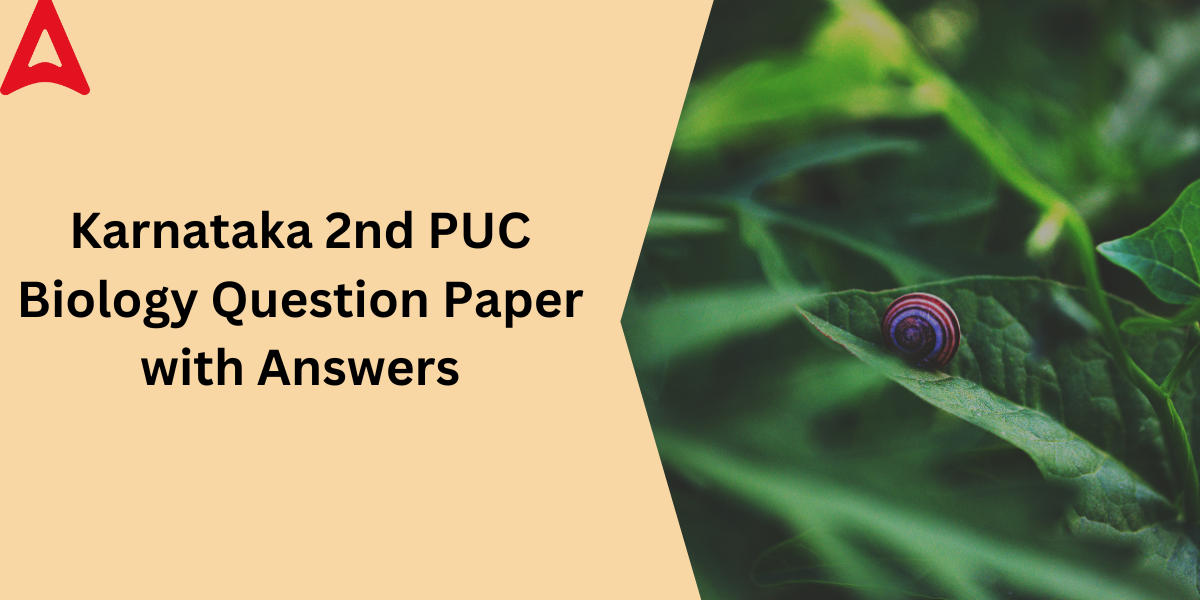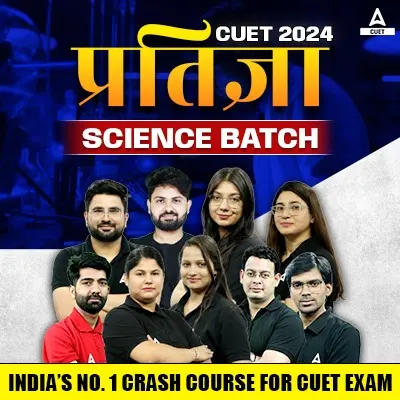The Karnataka School Examination and Assessment Board (KSEAB) has scheduled the Class 12 Biology exam for Monday, March 18, 2024. This is the time to fully prepare and review for the exam. The Karnataka 2nd PUC Biology Model Question Paper 2024 informs students on the pattern, types of questions, and marking scheme of the original Karnataka 2nd PUC Biology Paper 2024. All commerce students taking the second PUC Biology exam should download the official Model Paper and practice as much as possible in these last minutes.
2nd PUC Biology Model Question Paper 2024 with Answers
Biology is one of the major disciplines offered in the Science stream. Students preparing for the NEET Exam must perform well on the Biology exam. The board published a model paper for Karnataka 2nd PUC Biology to help students master question patterns and typology. Students will grasp the potential questions for the upcoming Biology exam. This helps students improve their time management abilities and knowledge. We present the 2nd PUC Biology Model Question Paper 2024 PDF to help prospective students understand the test scheme.
Karnataka 2nd PUC Biology Question Paper 2024
The Karnataka 2nd PUC Biology Question paper will follow the model paper format. The Karnataka 2nd PUC Biology exam carries 100 marks. A 70-mark biology theoretical paper will be assigned, followed by a 30-mark practical assessment. The newspaper will run for three hours and fifteen minutes.The question paper will be broken into four sections. Section A will consist of MCQs and fill-ins for 20 points. Section B will be worth 10 marks and will include internal choices. Section C will be evaluated for 15 points, followed by Section D for 25 points. Candidates are suggested to read the Karnataka 2nd PUC Biology Model Question Paper 2024 to understand the paper pattern in detail.
| Particulars | Details |
| Name of the Examination | Karnataka 2nd PUC Board Exam 2024 |
| Exam Conducting Body | Karnataka School Examination and Assessment Board (KSEAB) |
| Subject | Biology |
| Total marks in the Biology exam | 100 |
| Total Marks in Theory Paper | 70 |
| Total Marks in Practical Exam | 30 |
| Passing Marks | 33% in both Theory and Practical Exam |
| Duration of the Exam | 3 Hours 15 Minutes |
| Total Section of the Biology Paper | 5 Sections |
| Negative Marking | No |
2nd PUC Biology Paper Pattern 2024
As earlier mentioned the Model 2nd PUC Biology Paper introduces students to the paper pattern, types of questions, and difficulty level. check out the paper pattern listed below.
- The Karnataka 2nd PUc Biology Question Paper comprises four parts: A, B, C, and D.
- Part A-I contains 15 multiple-choice questions, while Part A-II contains 5 fill-in-the-blank questions.
- All questions in Parts A – I and II must be answered.
- Part B comprises 8 short answer style questions carrying 2 marks each, with 5 questions to be answered.
- Part C comprises 8 short answer style questions carrying 3 marks each, with 5 questions to be answered.
- Part D comprises of V and VI. Part D-V consists of 8 lengthy answer-style questions for 5 points each, with 4 questions to be answered.
- Part D-VI consists of three long answer type questions at five points each, with one question to be answered.
Karnataka 2nd PUC Biology Model Question Paper 2024
PART – A
I. Select the correct alternative from the choices given below: 1 x 15 = 15
1. Haploid conditionis not observed in which of the following cells
a) Synergids and Egg b) Zygote and PEN
c) Antipodal and Egg d) Antipodal and Synergids
Answer: b) Zygote and PEN
2. Statement I: Formation of fruit without fertilization is called apomixis
Statement II: In some species of Asteraceae and grasses seeds are formed without fertilization
a) Both Statement I and Statement II are correct
b) Both Statement I and Statement II are incorrect
c) Statement I is correct and Statement II is incorrect
d) Statement I is incorrect and Statement II is correct
3. During gestation the foetus develops limbs and digits by the end
a) First month b) Second month c) Third month d) Fifth month
Answer: b) Second month
4. The secondary oocyte after ovulation is covered by a non-cellular layer of
a) Cumulus oophorus b) Corona radiata
c) Zona pellucida d) Cortical layer
Answer: c) Zona pellucida
5. An example of hormone releasing IUD among the following
a) Cu – 7 b) Lippes loop c) LNG – 20 d) Multiload 375
Answer: c) LNG – 20
6. Which of the following is a foetal sex determination test?
a) ZIFT b) GIFT c) MTP d) Amniocentesis
Answer: d) Amniocentesis
7. Which of the following Mendelian gene disorder is the representation of allosomal recessive trait?
a) Hemophilia b) Thalassemia c) Sickle cell anemia d) Myotonic dystrophy
Answer: a) Hemophilia
8. The process of removal of introns and joining of exons in a defined order in a primary transcripts
occurs in
a) Prokaryotes b) Eukaryotes
c) Prokaryotes and Eukaryotes d) Prokaryotes and Protista
Answer: b) Eukaryotes
9. A type of Natural selection in which more individuals acquire mean character value is called
a) Stabilizing selection b) Disruptive selection
c) Directional selection d) Dominant selection
Answer: a) Stabilizing selection
10. Drug called “Heroin is synthesized by
a) Methylation of Morphine b) demethylation of Morphine
c) Acetylation of Morphine d) deacytalation of Morphine
Answer: c) Acetylation of Morphine
11. The fungus not used in the production of any Industrial product is
a) Penicillium b) Aspergillus c) Trichoderma polysporum d) Glomus
12. Significance of Insertional inactivation method in Recombinant DNA technology is to
a) Introduce the recombinants b) Isolate gene of Interest
c) Select the recombinants d) Select the gene of interest
13. Which of the following organisms are studied by Cornell’s in his elegant field experiments to study
competition
a) Warbler species
b) Chathamalus and Balanus
c) Cucko and Crow
d) Cattle egret and grazing cattle
14. The correct sequence in the process of decomposition is
a) Humification—-Leaching—-Catabolism—- Mineralisation —-Fragmentation
b) Catabolism—-Leaching—-Fragmentation—-Humification—- Mineralisation
c) Leaching—-Fragmentation —-Catabolism—-Humification—- Mineralisation
d) Fragmentation —-Leaching—-Catabolism—–Humification—-Mineralisation
15. Western Ghats have a greater diversity of
a) Amphibians b) Reptiles c) Aves d) Mammals
II. Fill in the blanks by choosing the appropriate word/Words from those given below: 1 x 5 = 5
(Commensalism, Alveoli,Ammensalism, Panspermia, Codominance, Perisperm)
16. The residual, persistent nucellus is called——-
17. The cells of ————secrete milk in the mammary glands.
18. AB blood group inheritance is an example for ————-
19. ——— is the theory that proposes that units of life called spores were transferred to different planets including earth
20. A population interaction in which one species is harmed and the other species is unaffected is ——
PART – B
Answer any FIVE of the following questions in 3 – 5 sentences wherever applicable: 2 x 5 = 10
21. List any four complications a person suffers from untreated sexually transmitted infections?
22. State the two medical grounds on which a pregnancy can be terminated according to the amended
Medical termination of pregnancy act 2017.
23. Give the phenotypes of the parental Drosophila that has produced 1.3% and 37.2% recombinants
respectively in T. H. Morgan Dihybrid cross experiment.
24. Differentiate divergent evolution from convergent evolution.
25. List any two differences between active and passive immunity.
26. What are primary lymphoid organs? Give two examples
27. Baculoviruses are excellent biocontrol agents in Integrated Pest Management. Comment.
28. Ecological pyramids have limitations. Justify the statement with two reasons.
PART – C
Answer any FIVE of the following questions in 40 – 80 words each wherever applicable:
(3 x 5 = 15)
29. a) Why is bagging of emasculated flowers essential during hybridization experiment?
b) Mention the cells of the mature pollen grain.
c) Give the scientific name of the plant that has the viability record of 10,000 years.
30. Explain the changes that occur in ovary and uterus during luteal phase of menstrual cycle.
31. Draw a diagrammatic sketch of the Lac operon when lactose is present in the medium
32. With respect to the evolution of man, name a, b, c, d, e, and f
| Period | Places of origin | Type of man |
| 2 million years ago b 1,00,000 – 40,000 years f |
a Java d Africa |
Australopithecines c e Homo sapiens |
33. Mention the three critical areas of biotechnology
34. What is gene therapy? Explain the steps involved in curing ADA deficiency by gene therapy.
35. a) Co-extinctions lead to loss of biodiversity. Justify the statement with two examples.
b) What are hot spots of biodiversity?
36. Describe the components of an aquatic ecosystem taking pond as an example
Karnataka 2nd PUC Biology Model Paper 2024 PDF
Solving practice question papers helps students improve their time management skills and comprehend the exam structure. It will also help to revise important topics by asking questions. We’ve included the Karnataka 2nd PUC Biology Question Paper 2024 PDF below.











 BTEUP Result 2025 Out at bteup.ac.in, Do...
BTEUP Result 2025 Out at bteup.ac.in, Do...
 SGBAU Result 2025 Out, Check Summer Seme...
SGBAU Result 2025 Out, Check Summer Seme...
 How To Prepare for CUET Accountancy Exam...
How To Prepare for CUET Accountancy Exam...



